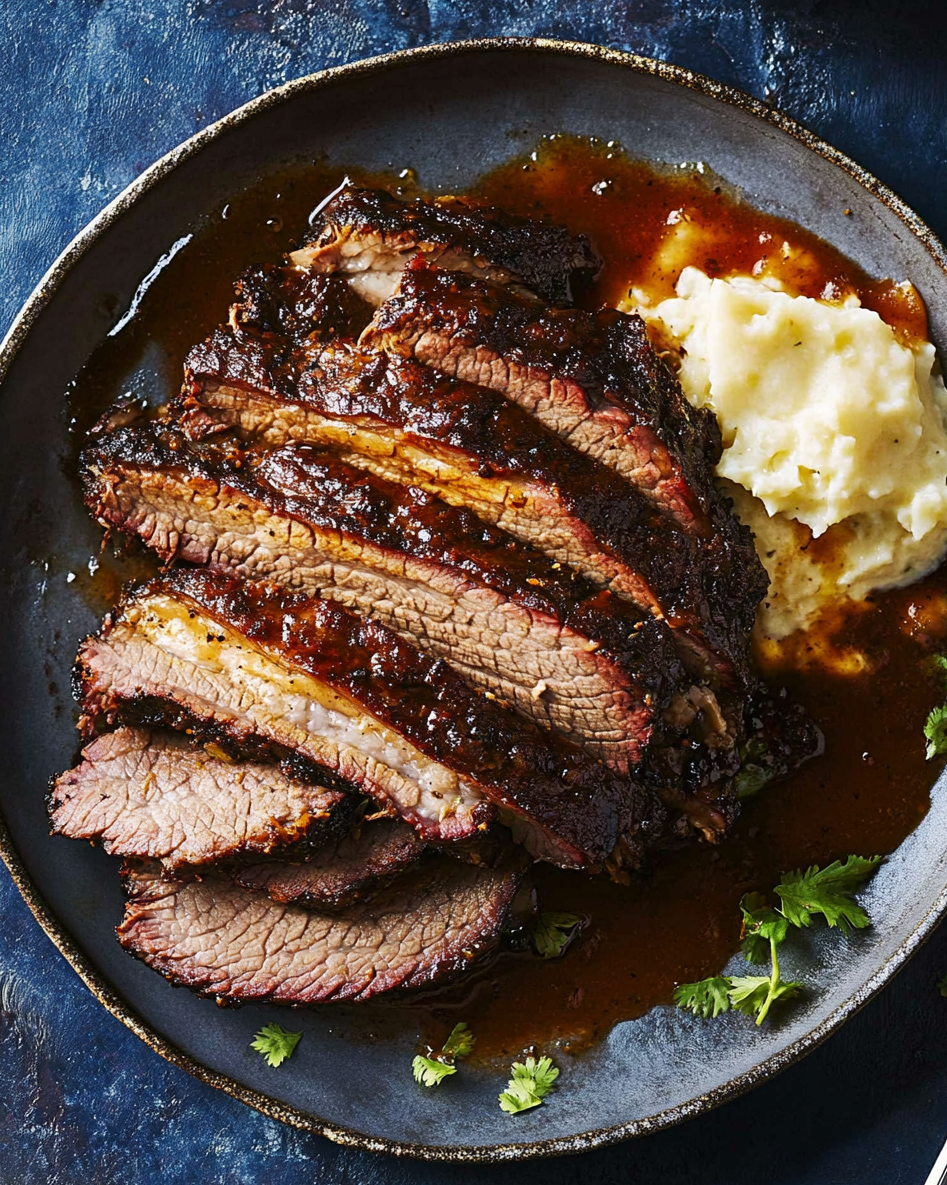This Sweet and Sour Brisket is a beloved traditional dish in many Jewish households, especially during the holidays. The beef brisket is slow-cooked to tender perfection in a deliciously tangy and slightly sweet sauce made with ketchup, vinegar, and brown sugar. The addition of onions and garlic enhances the flavor, creating a rich and savory gravy that perfectly complements the meat.
The beauty of this recipe lies in its simplicity and depth of flavor. It’s a perfect make-ahead dish, as the flavors meld beautifully when left to rest overnight. Serve this tender brisket with your favorite sides, like mashed potatoes or roasted vegetables, for a comforting and satisfying meal that brings warmth to any gathering.
Full Recipe:
- 3 to 4 pounds beef brisket
- 2 tablespoons olive oil
- 2 cups water
- 1 cup ketchup
- 1/2 cup apple cider vinegar
- 2 large onions, sliced
- 4 cloves garlic, minced
- 1 cup brown sugar
- 1 teaspoon salt
- Freshly ground black pepper, to taste
Directions:
- Preheat a large skillet or Dutch oven over medium-high heat. Add olive oil and brown the brisket on all sides.
- Once the brisket is browned, add water, ketchup, vinegar, onions, garlic, brown sugar, salt, and pepper to the skillet.
- Bring the mixture to a boil, then cover and reduce the heat to medium-low.
- Simmer for 2 hours and 30 minutes to 3 hours and 30 minutes, turning the brisket occasionally until it is tender.
- Remove the brisket from the skillet and let it cool before slicing against the grain.
- Arrange the sliced brisket in a 9×13-inch baking dish or large platter. Pour the gravy on top, cover, and refrigerate overnight.
- Before serving, remove any excess fat and reheat the brisket in the oven at 350°F (175°C) until heated through.
Prep Time: 15 minutes | Cooking Time: 3 hours | Total Time: 3 hours 15 minutes
Kcal: 450 kcal per serving | Servings: 6 servings
Background and Origins:
Sweet and Sour Brisket is a traditional Jewish dish that has deep roots in Eastern European cuisine. Brisket has long been a staple in Jewish cooking, particularly for holidays and family gatherings like Passover, Rosh Hashanah, and Hanukkah. The method of slow-cooking brisket was an economical way to tenderize this tougher cut of meat, making it flavorful and succulent. The sweet and sour flavor profile, often achieved with ingredients like vinegar and sugar or honey, is characteristic of many traditional Jewish recipes, providing a delightful balance that makes the dish both comforting and memorable.
Cooking Tips and Variations:
- Choosing the Brisket: When selecting brisket, look for a cut with a good amount of marbling. The fat helps keep the meat moist and tender during the long cooking process. A first-cut brisket (also known as the flat cut) is leaner, while the second cut (point cut) is fattier and can result in a richer dish.
- Cooking Method: This recipe can be prepared on the stovetop, as described, or adapted for a slow cooker or oven. Cooking the brisket low and slow is key to achieving a tender, melt-in-your-mouth texture.
- Overnight Flavor Development: Letting the brisket rest in its gravy overnight is crucial. This allows the flavors to deepen and meld, making it even more delicious the next day. Plus, it’s a convenient make-ahead option for busy holiday preparations.
- Vegetable Additions: For added flavor and texture, consider adding root vegetables like carrots, potatoes, or parsnips to the cooking liquid. These veggies soak up the sweet and sour sauce, becoming delicious accompaniments to the meat.
- Serving Suggestions: Traditionally, sweet and sour brisket is served with simple sides like mashed potatoes, egg noodles, or roasted vegetables. The gravy is perfect for drizzling over these sides, enhancing the entire meal.
Nutritional Information:
While brisket is a rich and hearty dish, it’s also a good source of protein and iron. By trimming excess fat before serving, you can make it a bit leaner. If you’re looking to reduce sugar intake, you can modify the amount of brown sugar or use a natural sweetener like honey.
Cultural Significance:
Sweet and Sour Brisket is more than just a meal; it’s a dish steeped in tradition and family heritage. It’s often associated with comfort, warmth, and the joy of gathering around the table with loved ones. In Jewish culture, food plays a pivotal role in celebrations and religious observances, with recipes like this one passed down through generations, often with each family adding their unique twist.
Wine Pairing:
To complement the sweet and tangy flavors of the brisket, consider pairing this dish with a robust red wine such as Cabernet Sauvignon or Merlot. The bold tannins and rich fruit notes of these wines balance the dish’s flavors, enhancing the overall dining experience.
Storing and Reheating:
This brisket tastes even better the next day. Store it in the refrigerator, covered, for up to 3 days. To reheat, warm the brisket in the oven at 350°F (175°C) until heated through, ensuring the gravy is bubbling slightly. You can also freeze the cooked brisket in an airtight container for up to 3 months.
Interesting Fact:
In the traditional Ashkenazi Jewish kitchen, the combination of sweet and sour was a practical way to make use of available ingredients. Vinegar or citrus would be used for acidity, while honey or sugar provided sweetness. This balance of flavors was thought to symbolize the bittersweet nature of life, particularly during holiday times when this dish would be served.
Historical Context:
Sweet and Sour Brisket has its roots in the Ashkenazi Jewish communities of Eastern Europe. During the 19th and early 20th centuries, Jewish immigrants brought this recipe to America, where it evolved with the introduction of new ingredients and cooking methods. In Eastern Europe, sweet and sour flavors were often achieved using basic pantry staples like vinegar, sugar, and dried fruits. Upon arrival in the United States, cooks adapted these flavors using ketchup and brown sugar, which added a modern twist to the classic dish. This melding of old-world techniques with new-world ingredients is a hallmark of Jewish-American cuisine.
Flavor Profile and Ingredients:
- Sweetness: The sweetness in this brisket comes from the brown sugar and ketchup. Brown sugar adds a molasses-like richness, while ketchup brings a subtle tanginess and depth of flavor. Some variations of this recipe might also include dried fruits like prunes or raisins to enhance the sweetness naturally.
- Sourness: Apple cider vinegar is a key ingredient in providing the sour component. It cuts through the richness of the beef and balances the sweetness of the sugar, creating a harmonious sauce that coats the meat beautifully. Some traditional recipes use lemon juice or even a splash of wine vinegar to achieve this tangy note.
- Umami and Depth: The onions and garlic not only add aromatic depth to the dish but also infuse the sauce with savory notes. As the brisket cooks, the onions break down and contribute to the sauce’s texture, making it even more luscious. Adding a bit of Worcestershire sauce or soy sauce can introduce an extra layer of umami if desired.
Cooking Techniques:
- Braising: This recipe uses a classic braising technique, where the brisket is first seared to lock in its juices and then slowly simmered in a flavorful liquid. Braising is ideal for tougher cuts of meat like brisket, which become tender and flavorful through long, slow cooking. The process of browning the meat at the beginning is crucial as it develops a rich, caramelized crust that enhances the overall taste of the dish.
- Resting and Slicing: Allowing the brisket to rest after cooking is essential for two reasons. First, it allows the meat fibers to relax, making it easier to slice without shredding. Second, resting overnight in the refrigerator gives the flavors time to meld and intensify. When slicing the brisket, it’s important to cut against the grain to ensure each slice is tender.
Serving Ideas and Presentation:
- Plating: For a more refined presentation, arrange the brisket slices on a large serving platter and drizzle them with the sauce. Garnish with fresh herbs like parsley or dill for a pop of color and freshness. Serve the brisket alongside roasted root vegetables or a simple green salad to balance the richness of the dish.
- Pairing with Sides: Sweet and Sour Brisket pairs wonderfully with a variety of sides. Classic options include potato kugel, latkes, or tzimmes (a sweet carrot and sweet potato dish). For a modern twist, consider serving it with creamy polenta, wild rice pilaf, or a medley of roasted vegetables. The sauce from the brisket can also double as a gravy for mashed potatoes or noodles, ensuring no drop of its deliciousness goes to waste.
Adaptations and Dietary Adjustments:
- Gluten-Free: This dish is naturally gluten-free if you ensure all ingredients, such as ketchup and other condiments, are gluten-free certified. Always check labels if serving to those with gluten sensitivities.
- Lower Sugar: For those looking to reduce sugar intake, the brown sugar in the recipe can be reduced or replaced with a natural sweetener like honey or agave syrup. Alternatively, using a sugar-free ketchup can help manage the sweetness while still delivering a delicious tangy flavor.
- Vegetarian Version: While brisket is a meat-centric dish, the sweet and sour sauce can be adapted for a vegetarian palate. Consider using portobello mushrooms or a meat substitute like seitan as the main ingredient, simmered in the sauce to absorb its rich flavors.
Holiday and Special Occasion Serving:
Sweet and Sour Brisket is a dish that shines on special occasions. During Jewish holidays like Passover, this dish often takes center stage on the dinner table. Its hearty nature makes it perfect for serving a crowd, and its make-ahead nature allows hosts to focus on other preparations. It’s also a favorite for Rosh Hashanah, where the sweet elements symbolize hopes for a sweet new year.
Leftovers and Repurposing:
- Leftover Brisket Sandwiches: One of the joys of making brisket is the leftovers. Thin slices of leftover brisket make for fantastic sandwiches. Layer the brisket on rye bread with a smear of mustard or horseradish sauce and add a slice of pickle for a satisfying meal.
- Brisket Tacos: For a creative twist, use the leftover brisket as a filling for tacos. Shred the meat and serve it in soft tortillas with a slaw made from cabbage, apple, and a tangy dressing to echo the sweet and sour flavors.
- Freezing: If you have a large quantity of leftovers, brisket freezes well. Portion it into freezer-safe containers with the sauce to keep it moist. When ready to use, thaw in the refrigerator overnight and reheat gently on the stovetop.
Cooking for a Crowd:
This recipe can easily be scaled up for larger gatherings. Simply increase the quantity of ingredients proportionally. Because the brisket can be made in advance and reheated, it’s an excellent choice for feeding a crowd without the stress of last-minute cooking. The rich aroma that fills the kitchen as it reheats is sure to whet everyone’s appetite.
Conclusion:
Sweet and Sour Brisket is a timeless dish that brings comfort, tradition, and rich flavor to the table. Its blend of sweet, tangy, and savory notes, combined with tender beef, makes it a perfect choice for holidays, family gatherings, or any special occasion. With its deep roots in Jewish cuisine and its adaptability for modern tastes, this dish is more than just a meal—it’s a celebration of heritage, warmth, and the joy of sharing food with loved ones.






